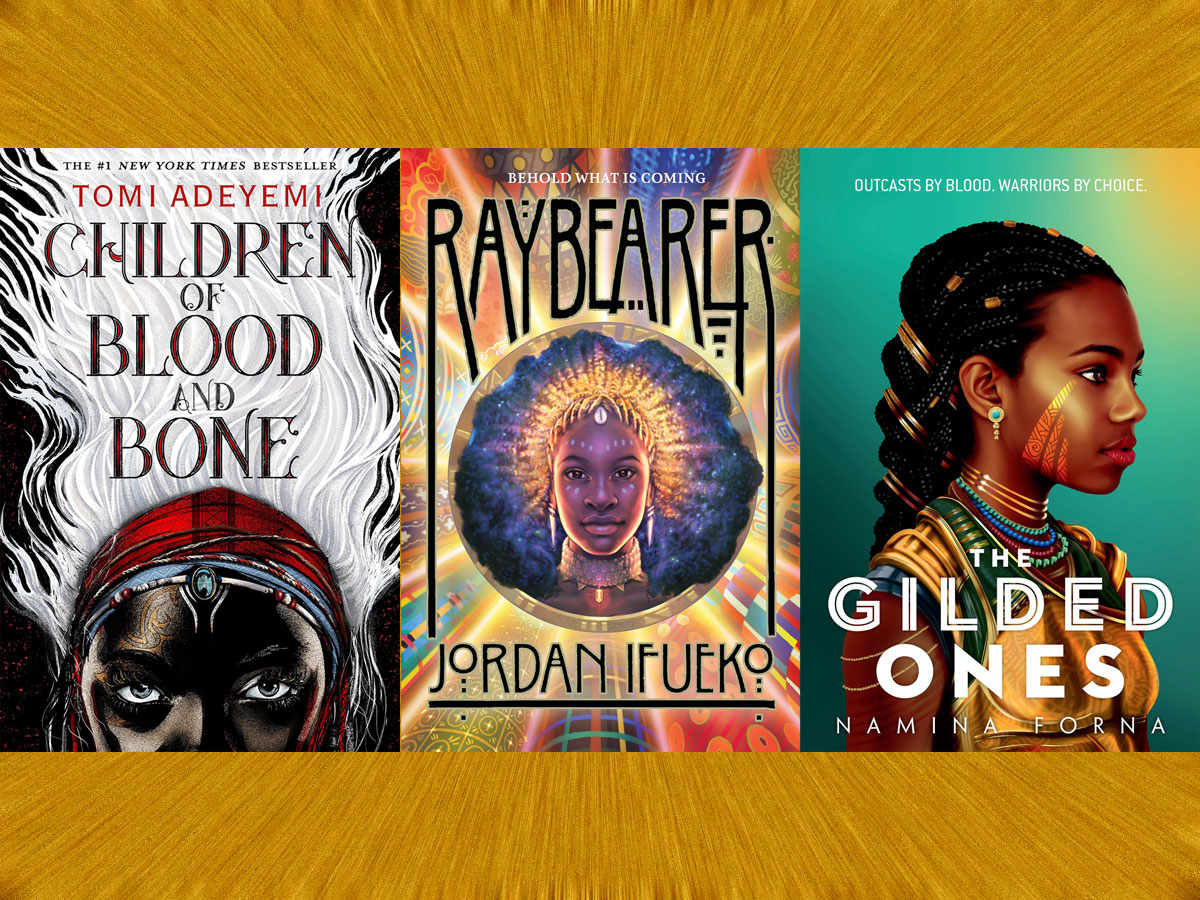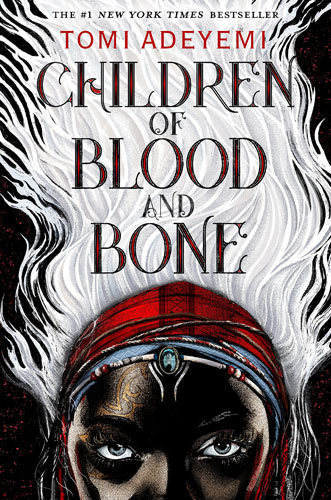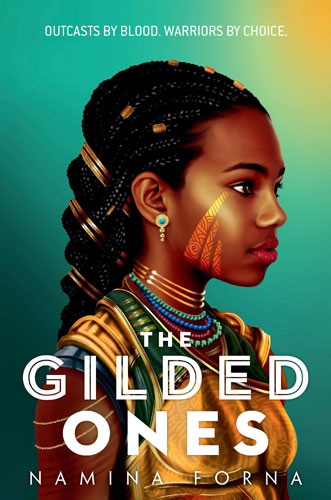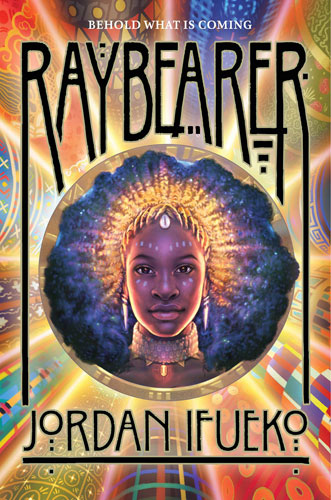This month, I’ve been reading some more books by Black authors—I’ve tried to diversify my reading a bit more year-round, but it does help me to have some annual reminders. This year in particular has highlighted the fact that we need more representation—more Black authors, more Black artists, more Black characters—both because it allows Black readers to see themselves in the story, and because it helps non-Black readers to see the world through different eyes. These past few weeks I’ve been reading some young adult fantasy books inspired by West African folklore and culture.
Children of Blood and Bone by Tomi Adeyemi
This is the oldest of the books in today’s column, published in March 2018. The book takes place in Orïsha, a land (inspired by Western Africa) that was once home to ten different clans of maji, each with their own type of magic. But then came the Raid: the king, whose family had been killed by fire-wielding Burners, determined to wipe out magic entirely, executing maji and disposing of the magical artifacts that gave them their power. Zélie was a young girl when her mother—a Reaper, who wielded powers tied to death—was captured and taken away in the Raid. She is a divîner, born with white hair as a sign that she would one day be a maji, but now divîners are a lower caste, referred to as “maggots” and often enslaved.
The story is narrated by four characters: Zélie and her brother Tzain (who isn’t a divîner himself), and the princess Amari and her older brother Inan. When it’s discovered that the magical artifacts have turned up and a few young divîners have become maji, it sets off a series of events. Amari steals the divine scroll from the palace and flees, eventually encountering Zélie and Tzain. They embark on a quest to restore magic. Inan, meanwhile, is sent to retrieve the scroll and ensure that magic is killed off for good. Each of them has their own assumptions about the world: the role of the maji, the dangers of magic, the best way to protect Orïsha. Who can be trusted?
It’s an exciting adventure: fight scenes, mythical creatures, ancient magic, romance, and a lot of internal conflict. Zélie wants to restore magic, but begins to fear that it may be too dangerous in the hands of some maji. Inan has always believed his father, that magic could destroy Orïsha, but has his eyes opened to the destruction that his father caused. I won’t spoil the story, but it kept me on the edge of my seat—and ended on a bit of a cliffhanger. Looks like I’ll need to find the second book, Children of Virtue and Vengeance.
The Gilded Ones by Namina Forna
The Gilded Ones was originally slated to be released May last year, but was pushed back to this month because of the pandemic. Otera is a nation made up of several provinces, and it seems a little like a microcosm of our world: those in the Northern Provinces seem like Europeans, while those in the Southern Provinces are similar to Africans, and other provinces have Asian-looking people and so on. Deka is a Northerner, but has always had trouble fitting in because of her dark skin, inherited from her mother. She hopes that she will finally be accepted after the Ritual of Purity, when all girls of age are cut to reveal their blood: red means they’re pure but gold blood will result in horrific consequences.
When Deka’s blood runs gold, even her father turns his back on her. A mysterious woman arrives and gives her a choice: remain in her village as an outcast, or join the emperor’s secret army of alaki—girls who have gold blood and strange powers. The alaki are nearly immortal and thus the ideal weapons against the monstrous deathshrieks that encroach on the borders of Otera, though even the male recruits they train with despise them. Deka discovers that even though she is an alaki, she is somehow different from them: she can sense the deathshrieks and has some other abilities that the other alaki don’t. As the story unfolds, we learn more about the origins of the alaki and the secret of the deathshrieks.
A lot of this story has to do with the role that girls and women play in the world of Otera. Namina Forna explains in her author’s note that she grew up in Sierra Leone in a deeply patriarchal society, and when she moved to America she was disappointed to discover that it wasn’t actually that different, just a little more subtle. The Gilded Ones is both a fantasy story with monsters and magic but it’s also about how girls and boys are treated differently, and the expectations that society places on them.
Raybearer by Jordan Ifueko
I’ve just started reading Raybearer, which was published in August 2020. Aritsar is ruled by an emperor and his council of Eleven, who are all connected to him through the Ray: it gives them the ability to communicate with each other telepathically and also binds them so they can’t survive without each other. It also makes the emperor immortal: he can only die from old age, or at the hand of one of the council members. So it’s crucial for the crown prince—the next raybearer—to select his council wisely, a process that begins when the prince is still a child. Children from all over the kingdom come to be candidates, hoping for the chance to be the one selected from their region.
Tarisai is one such candidate. She has been trained for this her entire life: she speaks a dozen languages, can solve puzzles in a flash, and has excellent fighting skills. She also has a secret: her mother, known only as The Lady, has sent Tarisai with a magical command to kill the Crown Prince. When Tarisai arrives at the palace, she immediately makes a connection to the prince (as well as some of the other candidates), and deeply desires the feeling of connection that would come from being on the Council and accepting the Ray. However, she also knows that the moment she accepts a seat on the Council, her mother’s command will be activated.
I’m only about halfway through the book so far, but it has been really fascinating so far. There’s more to the story behind the Ray and the council that has been hinted at, and I still haven’t learned what exactly the Lady’s grudge against the emperor is. But I do get a sense that the emperor is not entirely blameless, and there’s definitely some history there that is yet to be revealed. Also, the mental connection the council has with each other reminds me a little of the TV show Sense8, where a group of people is intimately connected to each other—though this being a young adult novel, it’s rated PG-13 rather than R. The next book in the series, Redemptor, is expected in August.
Black Cotton #1 by Patrick Foreman & Brian Hawkins, illustrated by Marco Perugini
And here’s one that’s not a fantasy novel based on Western Africa—instead, it’s a comic book that’s inspired in part by current events here in America. I saw a pitch for Black Cotton and was intrigued by the premise: the social order of “black” and “white” has been reversed. The story opens with a Black police officer shooting an unarmed white girl. The cop just happens to be Zion Cotton, the son of a billionaire, and this incident sets off protests, while the Cotton family scrambles to do damage control. This first issue mostly introduces the family and sets up the story so I can’t tell where it’s going, but I’m curious. In an interview, Foreman and Hawkins note that it’s not just a complete flip-flop of our world, but an alternate reality where Africans were never brought to the US as slaves (rather than a world in which they enslaved white people). There is still oppression in the world, but it came about a different way. Not that much has been revealed in the first issue, though, so we’ll see. I want to find out what kind of story these two Black men have to tell about race and power. Unfortunately the print edition is sold out, but you can still get the digital version from Scout Comics.
My Current Reads
Aside from the above, I also read Back to the Future: Delorean Time Machine: Doc Brown’s Owner’s Workshop Manual, an in-depth look at this famous contraption. I’ll have more about it in a future (ha!) column, but it includes a lot of diagrams and photos of the inner workings of the time machine, as well as plenty of journal entries from Doc Brown that spell out a bit more of the story—like what happened near the end of the first movie between Marty’s arrival back in 1985 and when Doc shows up worried about Marty’s kids.
Also, I should note that The Raconteur’s Commonplace Book by Kate Milford comes out this week! I’ll go into more detail about this one (hopefully next week) but if you’ve enjoyed the Greenglass House series you’ll definitely want to pick this one up. And if you haven’t—what are you waiting for? I did a Q&A with Kate Milford a few years back, and talked about the various books in the Milford-iverse, all of which are worth reading.
My relationship with books has gotten sort of weird—after over a decade of writing about books on GeekDad, I’m never at a loss for more books to read. Even with the past year, when publishers switched primarily to digital review copies instead of mailing physical copies, I still have piles of books on the floor of my office that don’t fit on the shelves. One of my favorite activities (in the beforetimes) was to wander through Powell’s Books and see what was new, despite the fact that a lot of what was new was arriving daily on my front porch. I just love the possibilities—the countless worlds I could dive into, the new things I could learn, the conversations that were waiting to happen within those covers.
There really is such a thing as too many options, and I think I’ve hit a saturation point over the past year. Oh, I’m still reading all the time, but I’ve become less interested in seeking out more books to add to the list while I still have so many I haven’t gotten to, even if some of the books in these piles have been there for a long time already. When I go through my emails every day, I’m deleting the majority of the pitches I receive, simply because I know I don’t have the capacity for them. (Sorry, authors and publishers!) Maybe if I can get through some more of these piles, I’ll feel more excited again about the prospect of new books.
Hope you’re staying warm and safe with all of this extreme weather we’ve had!
Disclosure: I received review copies or proofs of the books mentioned in this column; these affiliate links to Bookshop.org support my writing and also help independent booksellers!








